U.S. Department of Transportation
Federal Highway Administration
1200 New Jersey Avenue, SE
Washington, DC 20590
202-366-4000
FHWA's RSPCB Peer-to-Peer Program (P2P) supports and sponsors peer exchanges and workshops hosted by agencies.
Date
March 20 – 21, 2012
Hosts
Louisiana Department of Transportation and Development
Louisiana State University/Highway Safety Research Group
Key Participants
Connecticut Department of Transportation
Federal Highway Administration, Connecticut Division Office
Federal Highway Administration, Louisiana Division Office
Federal Highway Administration, Office of Safety
New Mexico Department of Transportation
University of Connecticut
University of New Mexico
U.S. DOT Volpe Center
FHWA's Office of Safety sponsors P2P events.
Learn more
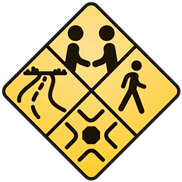
2. Crash Data: The Key to Better Safety Programs
5. Developing Action Plans for Connecticut and Mexico
In March 2012, the Connecticut (CTDOT) and New Mexico (NMDOT) Departments of Transportation met in Baton Rouge, Louisiana for a two-day peer session dedicated to exploring the intricate 12-year safety data partnership between the Louisiana Department of Transportation and Development (LADOTD) and Louisiana State University's (LSU) Highway Safety Research Group (HSRG) (see Appendix A for a complete list of participants). While CTDOT's and NMDOT's goals were slightly different, each wished to advance their electronic crash reporting efforts and develop more comprehensive and collaborative relationships with their respective state universities to collect, store, and analyze crash data.
This report summarizes the key lessons from this dynamic peer exchange and highlights the progress made by each agency in advancing their data partnerships.
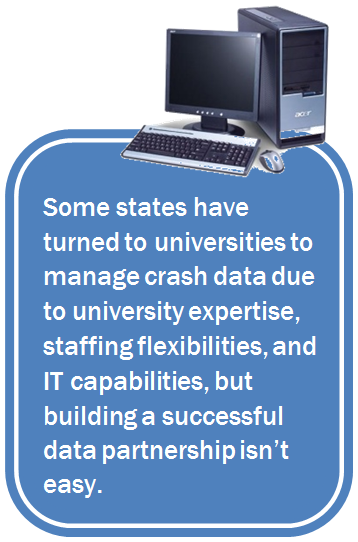
Because there are no uniform guidelines that dictate how states collect crash data, collecting, storing, analyzing, and accessing accurate and uniform crash data has led to a variety of challenges for the agencies responsible for these tasks, in many cases, state DOTs. States have a variety of models for managing these processes, so finding a successful model that best meets specific state needs can be challenging. Some state DOTs have turned to universities to help manage crash data due to the university expertise, staffing flexibilities, and IT capabilities, but building a successful data partnership is not an easy task. It requires dedicated leadership on both sides, a strategic and prioritized approach, and checks and balances to ensure data integrity and security. By studying the best practices developed during LADOTD's 12-year partnership with LSU, CTDOT and NMDOT hope to avoid pitfalls and advance their university crash data partnerships quickly and effectively.
At the time of the peer exchange, both Connecticut and New Mexico's data programs were in a state of transition. CTDOT's had a 14-month backlog for entering crash data and the agency was evaluating opportunities to share responsibility for data entry with the University of Connecticut (UCONN). NMDOT, on the other hand, had a minimal backlog but was preparing to transition responsibility for data collection from the New Mexico Corrections Department (NMCD) to the University of New Mexico (UNM). This transition was expected to result in a short-term backlog, but would offer the opportunity for New Mexico to revamp its data program.

Connecticut requested the peer exchange to gather information for implementing recommendations detailed in a Crash Data Improvement Program (CDIP) review, including actions to reduce its data entry backlog. CTDOT also wanted to gather feedback from Louisiana's experience to determine the extent of UCONN's potential role in collecting, managing, and analyzing Connecticut's crash data.
CTDOT's goal for the event was to understand whether Louisiana's model of collaboration would be adaptable to a relationship between CTDOT and the UCONN. In particular, Connecticut wanted to focus on:

NMDOT wanted to participate in the event because, at the time, they were planning to transition responsibility for collecting, reporting, and analyzing crash data to UNM. NMDOT planned to use this transition as an opportunity to revamp its crash data program; in particular NMDOT wanted to migrate its paper crash report to an electronic submission system through the Traffic and Criminal Software (TraCS). NMDOT planned to use peer exchange lessons to facilitate the development of a more automated, electronic, and interoperable crash data system to improve the timeliness, accuracy, completeness, and consistency of its data.

Both Connecticut and New Mexico wanted to glean best practices from LADOTD's data partnership with LSU/HSRG, which evolved over a period of more than ten years and included the development of a proprietary electronic crash reporting system, called LACRASH, used across the state. LACRASH helped transition the state from paper reporting to a primarily electronic reporting—by the end of 2012, more than 90% of all crash reports in the State were being filed electronically—saving the agency both time and money and essentially wiping out the problem of report backlogs.
Today, LSU's Highway Research Safety Group has become an integral part of LADOTD with 14 full-time employees and 12-20 graduate research students. Responsible for much more than data entry, HSRG is led by a statistician with experience evaluating seatbelt laws, red light cameras, and other legislative issues. This partnership not only offers LADOTD a scalable and robust data program, but also provides the agency with access to cutting-edge technology, through HSRG's research and experiments.
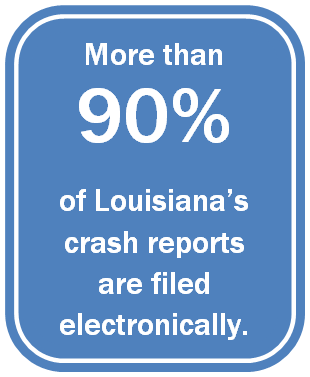
Through a three-year renewable contract, full-time HSRG employees are responsible for:
LADOTD uses data from LACRASH in all aspects of its safety program. LADOTD uses its data to identify needs for both spot improvements and systematic countermeasures through its Highway Safety Improvement Program (HSIP). HSRG has developed a website dedicated to data related to Louisiana's Strategic Highway Safety Plan (SHSP), given the data-driven nature of the plan. Louisiana also shares its data with local governments, Metropolitan Planning Organizations (MPOs), and the Louisiana State Police. These groups can request access to the data repository or can receive a file with all available data.
Louisiana has a goal of zero fatalities and improvements in its data systems are helping the State reach its goal. Fatalities in Louisiana have dropped from 992 in 2007 to 680 in 2011, even though Vehicle Miles Travelled (VMT) has remained relatively stable.
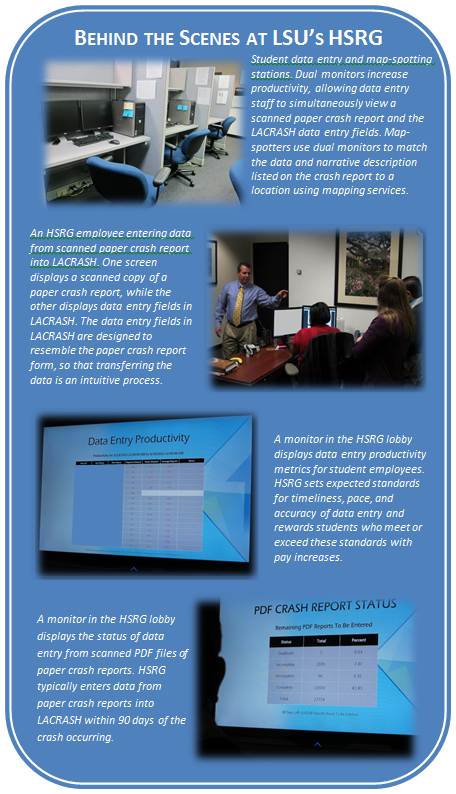
To make the most of the two-day workshop, the participating agencies met virtually several times prior to the event to share background information about Connecticut and New Mexico's crash data programs, identify common objectives, and develop a list of questions for LADOTD and HSRG to address in their presentations. The workshop was designed to encourage conversations on best practices that support successful roadway safety data partnerships between State DOTs and universities (see Appendix B for the agenda).
The workshop discussions focused on staffing, institutional, and funding issues related to university-DOT partnerships; safety data entry, data quality, and warehousing; business intelligence and GIS applications; and the relationship between crash data and the Highway Safety Improvement Program (HSIP) and Strategic Highway Safety Plan (SHSP). The workshop also provided dedicated time for Connecticut and New Mexico to develop action plans. During the action planning portion of the workshop, representatives from Connecticut and New Mexico separated and met independently with staff from LSU, LADOTD, and FHWA to discuss how they might apply the insights from Louisiana to the State's data program. The action planning session ensured that technical and program management staff found agreement on an approach to data program improvement. Following an initial action planning session, technical and program management staff met separately to hold more in-depth conversations about their relevant areas. In addition to the selected representatives who were able to attend in person, key staff from Connecticut and New Mexico participated in conversations via teleconference, video conference, and webinar to involve all critical parties while minimizing travel costs. The technical breakout focused on data entry, data quality, and warehouse structure; crash mapping and other data visualization; and data analysis and accessibility. The program management breakout focused on the details of agreements, contracts, and business processes between LADOTD and HSRG; staffing arrangements; and funding. Louisiana also arranged an onsite tour of the HSRG facilities so that all participants could see the data gathering process in action.
Connecticut and New Mexico absorbed a wealth of information from Louisiana, which they incorporated into action plans. With assistance from LADOTD and HSRG, Connecticut and New Mexico each identified their top challenges, program strengths, opportunities for improvement, and characteristics of their desired data program and system. Participants also indicated how input from Louisiana altered their views. Finally, each state identified their top actions and associated champions, stakeholders, and resources, as summarized below.
Following the peer exchange, FHWA arranged follow-up meetings with representatives from both Connecticut and New Mexico to continue their action-planning.
In the twelve months since the peer exchange, both New Mexico and Connecticut have made impressive strides in advancing their action plans.
All participants have continued their discussions following the event, with both New Mexico and Connecticut commenting that the peer workshop helped them more efficiently and confidently advance their university data partnerships plans. “Connecticut has a long way to go,” suggested the director of UCONN's Transportation Safety Research Center, “but now we have a road map in the LSU history.”
While serving as the “teacher” of the workshop, Louisiana benefited from telling its story and hearing the challenges of its peers, in particular how other agencies approached data dissemination and sharing responsibilities with the public and other agencies. One participant from LSU suggested that he gained a “clearer understanding of where states currently are in the process [of collecting crash data] and the challenges they face.”
By continually monitoring the progress of Connecticut and New Mexico, FHWA hopes to collect additional noteworthy practices that can be used to help other states improve their crash data programs. The University Data Partnership peer exchange is just one example of how agencies can effectively work together to address shared challenges more efficiently and effectively, which is essential in today's financial environment. To learn more about the University Data Partnership Workshop, please contact the Roadway Safety Professional Capacity Building Program (http://rspcb.safety.fhwa.dot.gov/contacts.aspx), or request a topic for your own peer exchange by filling out an application online (http://rspcb.safety.fhwa.dot.gov/p2p/p2p_app.aspx).
Representatives from Connecticut and New Mexico accomplished their goals for the peer exchange, which were to understand the contributing factors to the successful partnership between LADOTD and HSRG and identify elements to replicate in expanding the relationships with their respective universities.
Key findings from the event included the following:
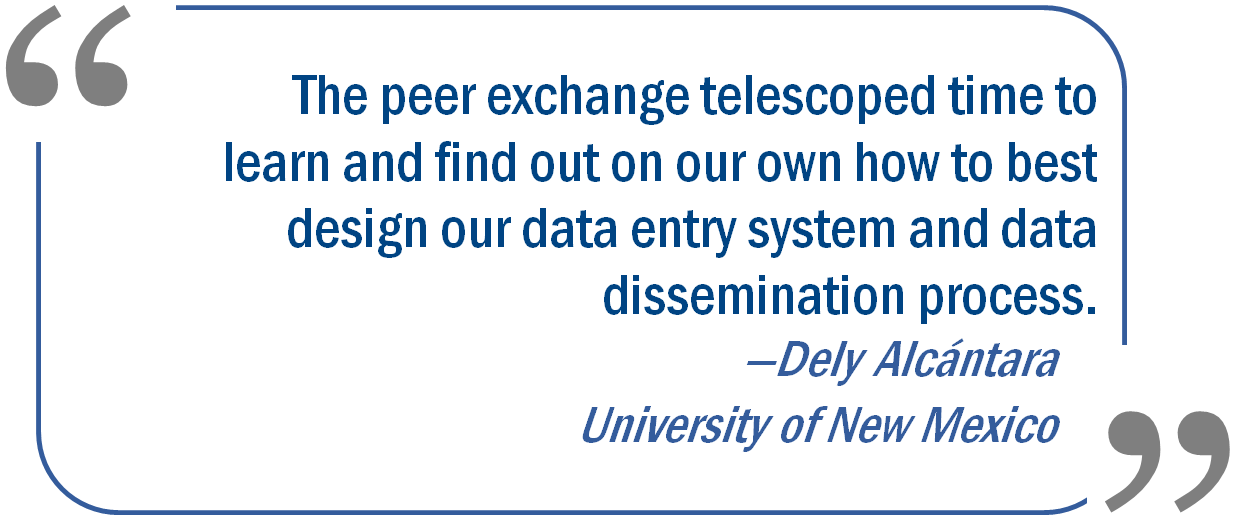
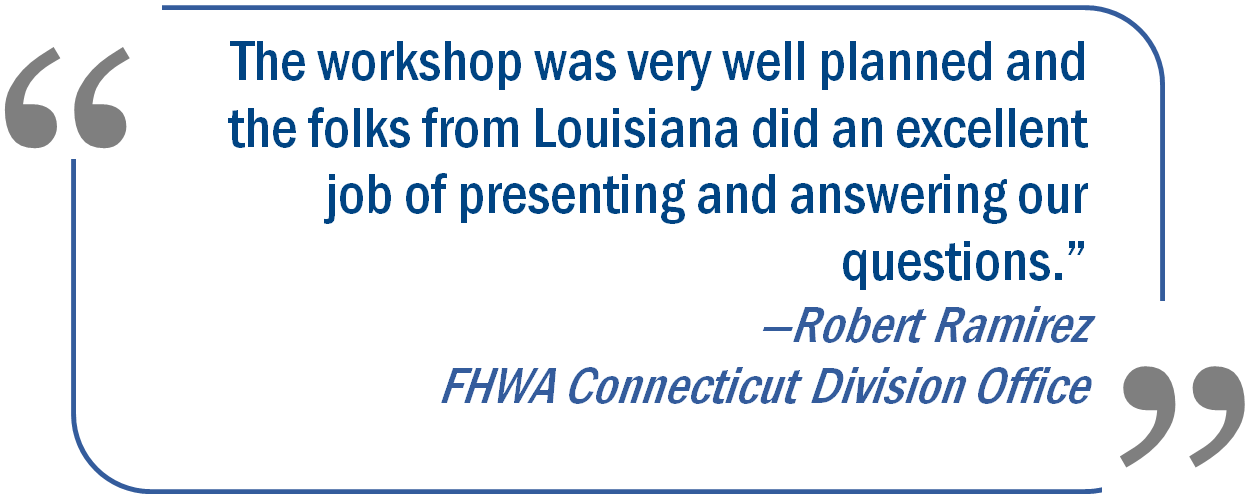
Roadway Safety Professional Capacity Building Program
http://rspcb.safety.dot.gov
| Attendees | |
|---|---|
| Kerry Ross Accident Records Section CTDOT Office Number: 860-594-2087 Work Email: Kerry.Ross@ct.gov |
Maribeth Wojenski Transportation Assistant Planning Director CTDOT Office Number: 860-594-2045 Work Email: Maribeth.Wojenski@ct.gov |
| Rory Belanger (Remote) Technical Analyst CTDOT Office Number: 860-594-3527 Work Email: Rory.Belanger@ct.gov |
Joseph Cristalli (Remote) Transportation Principal Safety Program Coordinator CTDOT Office Number: 860-594-2412 Work Email: Joseph.Cristalli@ct.gov |
| Thomas Maziarz (Remote) Bureau Chief, Policy and Planning CTDOT Office Number: 860-594-2001 Work Email: Thomas.Maziarz@ct.gov |
Jim Chapman Highway Safety EI LADOTD Office Number: 225-242-4574 Work Email: James.Chapman@la.gov |
| Alex Farr Engineer Intern LADOTD Office Number: 225-242-1844 Work Email: Alex.Farr@la.gov |
Dan Magri Highway Safety Administrator LADOTD Office Number: 225-379-1873 Work Email: Dan.Magri@la.gov |
| April Renard Highway Safety Engineer LADOTD Office Number: 225-379-1919 Work Email: April.Renard@la.gov |
Yolanda Duran Traffic Records Program NMDOT Office Number: 505-827-0961 Work Email: Yolanda.Duran@state.nm.us |
| Shelley Espinoza IT Projects Manager NMDOT Work Email: Shelley.Espinoza@state.nm.us |
Eric Jackson Assistant Research Professor UCONN Office Number: 860-486-8426 Work Email: e.Jackson@engr.uconn.edu |
| Julianne Alt Computer Analyst Highway Safety Research Group/LSU Office Number: 225-578-0366 Work Email: jserbe1@lsu.edu |
Charles Cavalier Business Analyst Highway Safety Research Group/LSU |
| Sara Graham Research Associate Highway Safety Research Group/LSU Office Number: 225-578-0239 Work Email: sgraha2@lsu.edu |
Christy Guempel Computer Analyst Highway Safety Research Group/LSU Office Number: 225-578-5283 Work Email: cguempel@lsu.edu |
| Cory Hutchinson Associate Director/TRCC Coordinator Highway Safety Research Group/LSU Office Number: 225-578-1433 Work Email: cory@lsu.edu |
Chris Holbrook Computer Scientist Highway Safety Research Group/LSU Office Number: 225-578-0366 Work Email: cholbr1@lsu.edu |
| Eric Newman Research Associate Highway Safety Research Group/LSU Office Number: 225-578-4095 Work Email: ericnewman@lsu.edu |
Helmut Schneider Director HSRG Office Number: 225-578-2516 Work Email: hschnei@lsu.edu |
| Mark Verret Network Analyst Highway Safety Research Group/LSU Office Number: 225-578-0283 Work Email: mark@lsu.edu |
Dely Alcantara Director, Geospatial and Population Studies UNM Office Number: 505-277-8823 Work Email: dalcant@unm.edu |
| Srini Vasan Data Manager UNM Office Number: 505-277-4034 Work Email: svasan01@unm.edu |
|
| FHWA/Volpe | |
| Bob Ramirez Traffic and Safety Engineer FHWA Connecticut Division Office Office Number: 860-659-6703, ext. 3004 Work Email: Robert.Ramirez@dot.gov |
Betsey Tramonte Safety Program Coordinator FHWA Louisiana Division Office Office Number: 225-757-7613 Work Email: Betsey.Tramonte@dot.gov |
| Tamiko Burnell Transportation Specialist FHWA Office of Safety Office Number: 202-366-1200 Work Email: Tamiko.Burnell@dot.gov |
Kevin Jones Transportation Specialist FHWA Office of Safety Office Number: 202-366-1320 Work Email: Kevin.Jones@dot.gov |
| Bob Pollack Transportation Specialist FHWA Office of Safety Office Number: 202-366-5619 Work Email: Robert.Pollack@dot.gov |
Jeremy Crowell IT Specialist Volpe Center Office Number: 617-494-2824 Work Email: Jeremy.Crowell@dot.gov |
| David Perlman Operations Research Analyst Volpe Center Office Number: 617-494-3178 Work Email: David.Perlman@dot.gov |
|
Transportation Training and Education Center
4099 Gourrier Avenue
Baton Rouge, Louisiana
Times printed in red will include an option for video conferencing.
| Tuesday, March 20, 2012 – Peer Exchange - Room 175 (unless otherwise indicated) | |
|---|---|
| 8:00 a.m. | Welcoming Remarks, Overview, Introductions, and Expected Outcomes
|
| 8:30 a.m. | Peer-to-Peer Program Background
|
| 8:40 a.m. | FHWA Data Programs Overview – Roadway Safety Data Partnership Program and Crash Data
Improvement Program
|
| 9:00 a.m. | Peer Presentation - Connecticut
|
| 9:30 a.m. | Break |
| 9:40 a.m. | Peer Presentation – New Mexico
|
| 10:10 a.m. | Peer Presentation – Louisiana
|
| 11:10 a.m. | Lunch |
| 12:15 p.m. | Group Discussion – University Partnerships
|
| 2:15 p.m. | Break
|
| 2:30 p.m. | Action Planning (Part 1) Connecticut – Room 175; New Mexico – Executive Conference Room
|
| 4:00 p.m. | Wrap-Up (Room 175)
|
| 4:15 p.m. | Adjourn |
| Wednesday, March 21, 2012 | |
|---|---|
| 8:00 a.m. | Tour of LSU Facilities (Meet at TTEC) |
Following the recap of Day 1, the group will split into program managers and data/technical staff.
|
|
||||||||||||||||
Program managers and data/technical staff will reconvene as one group for the remainder of Day 2.
| 12:30 p.m. | Next Steps for Louisiana’s Crash Data Systems (Room 175) |
| 1:30 p.m. | Action Planning (Part 2) Connecticut – Room 175; New Mexico – Executive Conference Room
|
| 3:45 p.m. | Wrap-Up and Next Steps (Room 175) |
| 4:30 p.m. | Adjourn |
